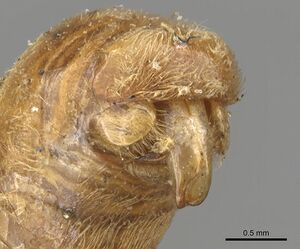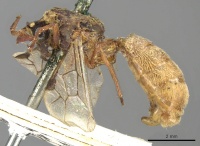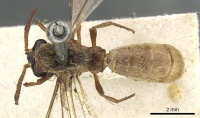Aenictus ambiguus
| Aenictus ambiguus | |
|---|---|

| |
| Scientific classification | |
| Kingdom: | Animalia |
| Phylum: | Arthropoda |
| Class: | Insecta |
| Order: | Hymenoptera |
| Family: | Formicidae |
| Subfamily: | Dorylinae |
| Genus: | Aenictus |
| Species: | A. ambiguus |
| Binomial name | |
| Aenictus ambiguus Shuckard, 1840 | |
The type species of the genus, it is only known from the male caste. Nothing is known about the biology of Aenictus ambiguus.
Identification
Distribution
From Sikkim (Rungit Valley) west to Agra Presidency (N. W. provinces) south to Gujarat and Poona (Wilson 1964).
Distribution based on Regional Taxon Lists
Oriental Region: India (type locality), Nepal.
Distribution based on AntMaps
Distribution based on AntWeb specimens
Check data from AntWeb
Countries Occupied
| Number of countries occupied by this species based on AntWiki Regional Taxon Lists. In general, fewer countries occupied indicates a narrower range, while more countries indicates a more widespread species. |

|
Estimated Abundance
| Relative abundance based on number of AntMaps records per species (this species within the purple bar). Fewer records (to the left) indicates a less abundant/encountered species while more records (to the right) indicates more abundant/encountered species. |

|
Biology
Castes
Images from AntWeb
 
| |
| Type of Aenictus ambiguus. Male (alate). Specimen code casent0901947. Photographer Ryan Perry, uploaded by California Academy of Sciences. | Owned by OUM, Oxford, UK. |
Only knowm from the male caste.
Nomenclature
The following information is derived from Barry Bolton's Online Catalogue of the Ants of the World.
- ambiguus. Aenictus ambiguus Shuckard, 1840b: 268 (m.) INDIA (Maharashtra).
- Type-material: holotype male.
- [Note: comments on type-material: Wilson, 1964a: 444.]
- Type-locality: India: Poona in Bombay (Sykes).
- Type-depository: OXUM.
- Status as species: Westwood, 1842: 79; Smith, F. 1859b: 9; Roger, 1863b: 41; Mayr, 1863: 394; Smith, F. 1871a: 336; Dalla Torre, 1893: 7; Forel, 1901a: 469; Bingham, 1903: 9; Forel, 1904c: 20; Forel, 1906b: 91; Emery, 1910b: 30; Menozzi, 1939a: 326; Chapman & Capco, 1951: 14; Wilson, 1964a: 444; Bolton, 1995b: 58; Bharti, Guénard, et al. 2016: 20.
- Distribution: India.
Unless otherwise noted the text for the remainder of this section is reported from the publication that includes the original description.
Wilson (1964) - Holotype: Since this species is the type species of Aenictus, a special effort has been made to locate and identify the male type. In the publication of W. Horn and I. Kahle on insect collections (1936, Ent. Beihefte in Berlin-Dahlem 3: 161-296) the collection of William Edward Schuckard is stated to have been auctioned in 1868 via J. C. Stevens from London. Mr G. E. J. Nixon (per. comm. 1963) informs me that no specimen referable to the type can be found in the British Museum, one likely repository in England. Mr Ernest Taylor, on the other hand, has located a single male labeled "Aenictus Schuck. ambiguus.Ind " on what appears to be a very old label, in the Oxford University Museum. I am indebted to Mr Taylor for the loan of this specimen. Unfortunately, Horn and Kahle did not publish a sample of Schuckard's handwriting, so that the Oxford specimen cannot be readily authenticated in this manner. However, it does fit the concept of A. ambiguus of past ant taxonomists, especially Bingham, Forel and Wheeler, and it would seem to be usefully regarded as the type specimen. Three males in the collection at the Museum of Comparative Zoology have been compared in detail to it and are available for future reference when the exact worker-male association can be made. Meanwhile, it can be confirmed that the Oxford specimen is indeed an Aenictus, and it is further possible to trace it with some confidence to the pachycerus group. Beyond this, placement is less easy. It is certainly not aratus. The Walajanagar males belonging to aratus have medium brown pedicel and gaster, only slightly lighter in shade than that of the mesosoma and head, whereas in the ambiguus type the pedicel and abdomen are dark yellow, contrasting to the medium brown mesosoma and head; the mandibles of the aratus males are shorter and broader; the median impression of the petiole is also distinctly less deep in the aratus males. If our conclusion is correct that ambiguus is a member of the pachycerus species group, and if it is the male of a species also known from the worker, there remain 8 species in the group after we have eliminated aratus: Aenictus biroi, Aenictus dentatus, Aenictus pachycerus, Aenictus philippinensis, Aenictus philiporum, Aenictus punensis, Aenictus rabori, Aenictus reyesi. All but pachycerus and punensis can be eliminated on the basis of their distribution. Of the remaining 2, punensis is the less likely, since it appears to be relatively rare and possibly also local in distribution. On the other hand, the distribution of pachycerus encompasses that of ambiguus. Both pachycerus (known only from workers) and ambiguus (known only from males) are abundant within their broadly overlapping ranges. When worker-male associations are made, ambiguus should be readily recognizable by fig. 90 and the more detailed figures of Bingham (1903), and the identification can be made definite by comparison with either the Oxford type or the closely compared specimens in the Museum of Comparative Zoology. The HW of the Oxford type, across and including the eyes, is 1.66 mm. Besides the characters implicit in fig. 90 and the distinctive coloration already mentioned, it may be important that the entire body of this specimen is covered with dense, appressed, pale yellow hairs.
Description
Male
Reddish testaceous, covered with a close silky down; head, with the exception of the antennae and mandibles, which are of the same color as the body, black and shining; ocelli placed upon an eminence on the vertex, in a curve; mandibles very long, much curved, somewhat broadest at the base, pubescent externally, and when closed leaving a wide space between them and the c1ypeus, upon the anterior margin of which the antennae are inserted in a cavity, the inner carinated edges of which join in the centre of the face, forming a single carina, which extends to the anterior ocellus. Antennre rather robust, equally thick throughout, the scape not thicker than the flagellum and about one third its length.
Thorax black, or sometimes pitchy, covered with a close decumbent down; convex, very gibbous at the scutellum, which is quadrate: superior wings with the nervures and stigma brown; the tegulre testaceous; legs short, slender, testaceous, and covered with long loose hair.
Abdomen testaceous, covered with close decumbent down, with the peduncle wider than the second segment, deeply canaliculated, and of the shape of a saddle reversed, rounded at the base; the terminal segment rounded and obtuse.
Bingham (1903) - Head jet-black, shining; thorax deep brown; antenna, mandlbles, legs, and abdomen yellow. Head constricted behind the eyes, smooth and shining at back, with short erect pubescence in front; mandIbles long, sickle-shaped. Thorax very convex above; scutellum prominent, truncate, or slightly emarginate posteriorly, overhanging the postscutellum and metanotum; this last almost vertical, with little or no basal portion; the whole thorax covered with long, recumbent, whitish-yellow hairs: legs comparatively long, With the femora and tibiae cylindrical, not compressed, and only very slightly and gradually clavate towards the apex; wings clear hyaline, nervures yellowish brown. Pedicel about as wide as the base of the abdomen, concave from right to left, the sides parallel; abdomen subclavate, bent downwards, pubescent, the hairs long, yellowish white, recumbent.
Type Material
Wilson (1964) - Type locality: N. W. Prov., India.
References
- Bingham, C. T. 1903. The fauna of British India, including Ceylon and Burma. Hymenoptera, Vol. II. Ants and Cuckoo-wasps. London: Taylor and Francis, 506 pp. PDF
- Gomez, K. 2022. A revision of the Afrotropical species of the Dorylinae ant genus Aenictus (Hymenoptera: Formicidae) based on the worker caste. Belgian Journal of Entomology 124: 1–86 (doi:10.5281/zenodo.5898821).
- Shuckard, W. E. 1840b. Monograph of the Dorylidae, a family of the Hymenoptera Heterogyna. (Continued from p. 201.). Ann. Nat. Hist. 5: 258-271 (page 268, male described)
- Subedi, I.P., Budha, P.B., Bharti, H., Alonso, L. 2020. An updated checklist of Nepalese ants (Hymenoptera, Formicidae). ZooKeys 1006, 99–136 (doi:10.3897/zookeys.1006.58808).
- Wilson, E. O. 1964a. The true army ants of the Indo-Australian area (Hymenoptera: Formicidae: Dorylinae). Pac. Insects 6: 427-483 (page 445, see also)
References based on Global Ant Biodiversity Informatics
- Karmaly K. A.; S. Sumesh, T. P. Rabeesh, and L. Kishore. 2010. A checklist of ants of Thirunelli in Wayanad, Kerala. J. of the Bombay Natural History Society 107(1): 64-67.



